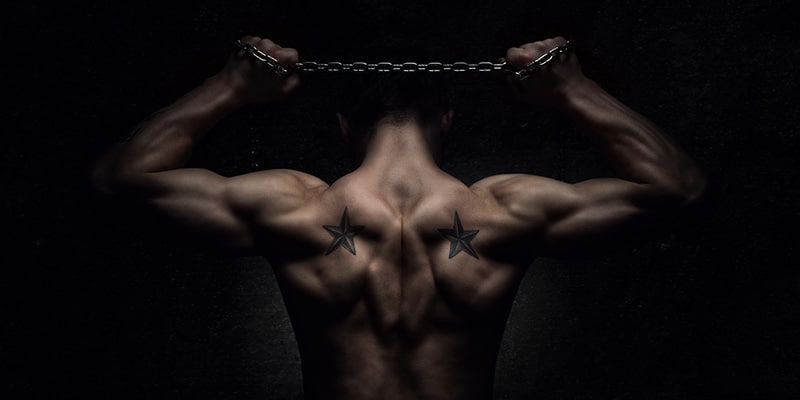How to Craft Some Serious Traps

When you look at a bodybuilder, you see sculpted legs, chiseled abs, enormous arms and HOLY COW THOSE TRAPS! There’s nothing more standout than a set of prominent, powerful trapezius muscles. They exude strength and balance out the look of the whole body. Without them, a mammoth bodybuilder ends up looking like a bobblehead. With them, they look tough and toned. The problem is that crafting serious traps is no easy feat. Many make the attempt and few come out the other side with enviable muscles.
So what exactly do you need to do to build bigger traps? Part of the equation is education and the other half is execution. You’ve got to know your traps, know the right exercises and then do them. You need to do a ton of them. Here’s everything you need to know about effectively building up your trap muscles.
First, Find Your Traps

The first step in creating hulking traps is to understand what you’re after. Of course you know where your traps are. If you didn’t, you wouldn’t be trying to improve them in the first place. But you have to fully understand their function and mechanics before you can build enviable, monster traps.
For starters, what you think are your trapezius muscles are really only the tip of the iceberg. “The trapezius muscles are more than just the muscles on the side of your neck and behind it,” according to BodyBuilding.com. “The traps are actually a huge muscle group, and are larger than the abdominals.” This muscle group is huge and if you’re only training to see progress at the little bit by your neck, you’re missing out.
“The entire trapezius starts up by your neck, ties in with the side and rear deltoids and then connects with the spine down to the middle back.” It’s a whopping chunk of real estate on the backside of your body. Your traps are always at work. They raise your scapulae, turn your head, keep your shoulder joints stable and serve a secondary role when you’re pulling things, according to BodyBuilding.com. Knowing this can help you plan your routine around building your traps and to make sure you’re hitting all of the major functions of the muscle group when you’re training.
Master The Shrug

If you want to get serious about building colossal traps, you need to master the “shrug” motion. Not a “meh” kind of shrug. But a full-on shrug that can help you craft the top, most visible portion of your traps. This is not your standard shrug. You’ll need some kind of resistance, like a straight Olympic bar, dumbbells or cables. “The type of weight you use doesn’t matter,” says BodyBuilding.com , “but how you perform the movement is what separates the men from the boys.”
No matter which weight you choose to use, the exercise motion will be the same. Get your weight, pick it up and let it hang so you can feel a slight stretch in your neck and traps. This should just feel like a gentle tug; you shouldn’t experience any pain. Pull up on your weight with a shrugging motion, being careful not to engage your biceps or triceps. Think about firing up your traps and only your traps and, when you get to the top of your movement, squeeze them.
Here’s the kicker: you’ve got to do that 49 more times. That’s one set. Do three sets total. That’s 150 total shrugs. You’ll be feeling them the day after your workout for sure.
Get Crazy, But Not Too Crazy
The shrug is just the beginning of the road to ridiculous traps. There are loads more moves you can master to get those coveted bulkier, stronger traps. Here are a few more weapons for your trap-building arsenal.
The High Pull
To start your high pull, get yourself an olympic bar and stack it with weight that’s about 50 percent more than you’d use for an upright row, according to BodyBuilding.com. Grab the bar underhanded with your hands positioned a little wider than your shoulders. Allow the bar to hang, then lower the bar, keeping your lower back arched and your butt and shoulders back.
“When the bar reaches about two inches above the knee cap,” says Bodybuilding.com, “use your traps, shoulders, hips and legs in unison to bring the bar to your chest. Once the bar is there, gravity will bring it back down. Use your hips and legs as shock absorbers.”
The Dumbbell Lateral Raise
The Dumbbell lateral raise may target your middle deltoid the most, but your traps are active and engaged during the motion, according to Men’s Health. They’re going to stabilize the movement and get stronger in the process. With a pair of dumbbells in your hands, allow your arms to hang by your sides while you stand tall, feet shoulder-width distance apart. Bend your elbows slightly and face your palms forward. Raise your arms straight out to your sides so your body forms a T shape. Be sure to keep a little bend in your elbows. Pause for a second at the top of the motion and then slowly bring your weights back down to starting position.
The Upright Row
The upright row is a classic, but it’s ubiquitous for good reason. It’s simple, easy and super effective. All you need is a barbell or some dumbbells and a little bit of space. Stand up straight and pull your weights up to chest level. Any higher and you risk irritating your shoulder joints.
Now you’re equipped with everything you need to know to start crafting the strong, defined trapezius muscles you’ve always wanted. You know where your traps really are, what exactly it is that they do and how to harness your workout to build them up. Now all you’ve got to do is get working.
Performance Inspired Nutrition is all over social media and if you haven’t followed or liked us yet, you’re already behind. Find us on Facebook, Twitter and Instagram and catch up with the latest information and inspiration.


